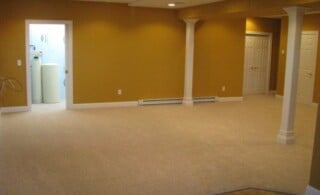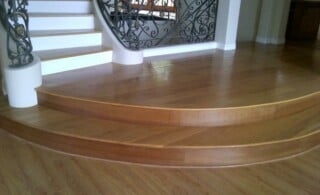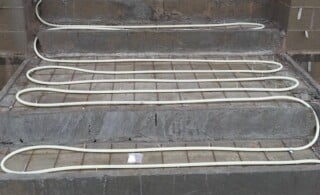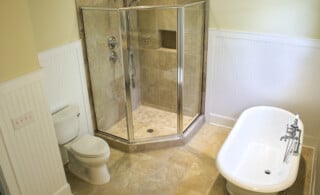
Photo: Pixel-Shot / Adobe Stock
Tile and wood flooring are both solid choices as part of an upscale aesthetic in your home. Wood is warm and inviting with a traditional, luxurious appearance that’s hard to beat. Natural stone tile has a rugged, earthy appearance that’s super-contemporary yet timeless, and manufactured tile, like porcelain or ceramic, feel cooler to the touch. Find out the differences between these two popular flooring types and decide which is best for your flooring project.
On This Page:
- What’s the Difference Between Tile and Wood Flooring?
- Tile vs. Wood Flooring: Which Is Better?
- Tile vs. Wood Flooring: Which Is Best for Your Home?
- Tile vs. Wood vs. Laminate
What’s the Difference Between Tile and Wood Flooring?
Tiles come in natural stone or manufactured variants and are available in a huge range of colors, patterns, and textures. Wood flooring comes in solid hardwood planks or as engineered wood, which is manufactured in layers. Let’s take a look at the key differences.
Tile Flooring

Photo: Cinematographer / Adobe Stock
Tile flooring is available in manufactured materials, including ceramic, porcelain, and resin, or natural stone, including slate and granite. If you want a tiled floor, expect to pay between $9 and $65 per square foot.
Types of Tile Flooring
| Type | Cost per Square Foot | Description |
|---|---|---|
| Ceramic | $9 – $44 | Ceramic tile costs less than most other tiles Lots of choice in color, pattern, and design Great for high traffic and damp areas |
| Porcelain | $11 – $44 | Extremely durable Resists cracking and chipping Great choice for high-traffic areas Waterproof so good choice for kitchens and bathrooms |
| Slate | $12 – $35 | Natural textured stone that’s slip-resistant Requires sealing to remain waterproof Extremely durable Black to gray, contemporary appearance |
| Travertine / Limestone | $10 – $44 | Porous natural stone with a rough texture Durable but only waterproof when sealed Requires resealing periodically |
| Granite | $18 – $50 | Most common type of stone tile Large color choice Needs sealing if using in bathrooms and kitchens |
| Marble | $11 – $65 | Natural and manufactured varieties Prone to scratches and staining unless properly sealed Not the most durable stone but gives a luxurious appearance |
| Fired Stone | $10 – $50 | Fired stone tiles are extremely durable Textured and naturally slip-resistant |
| Resin | $10 – $50 | Unique designs Can dent, chip and scratch easily Use as accents or for walls, ceilings and backsplashes |
Wood Flooring

Photo: Bmak / Adobe Stock
There are plenty of options when it comes to wood flooring, ranging from manufactured engineered wood, which has a thin veneer of real hardwood on top of base layers usually made from fiberboard, to solid hardwood. Solid hardwood is available in common, budget-friendly wood types to exotic, expensive species and vintage reclaimed wood.
Types of Wood Flooring
| Type of wood | Cost per square foot | Description |
|---|---|---|
| Solid unfinished planks | $6 – $12 | Sealant applied after installation creates a complete waterproof Easy to sand and refinish multiple times |
| Solid prefinished planks | $6 – $12 | Faster to install than unfinished planks because there’s no final sealing step Don’t need resealing as frequently as unfinished planks Floor is not completely waterproof, as water can seep into the joins |
| Reclaimed hardwood planks | $15 – $30 | Unique weathered appearance from age and use Upcycling old planks is environmentally friendly Reclamation, restoration, and scarcity result in an expensive product |
| Hand-scraped planks | $10 – $20 | Rustically uneven, unique appearance Easy to maintain Dings, scuffs, and scratches blend into the existing finish |
| Engineered wood planks | $4 – $16 | High-end engineered flooring is indistinguishable from solid hardwood High-density fiberboard core is topped with a veneer of real hardwood |
Tile vs. Wood Flooring: Which Is Better?
Tile and wood flooring are both good choices for interior home flooring. But which is the best choice for you depends on your lifestyle, your budget, and which rooms you’re remodeling. For example, you need different flooring in the bathroom compared to in the family room. Take a look at which type of flooring comes out on top in each of the most important categories.
Appearance
The flooring you choose has a significant impact on the aesthetic of your living space. It should match the personality of the rest of the space, including walls, furniture, and furnishings for a cohesive look.
Tile Flooring Pros:
- Stone tiles have a distinctively rugged, earthy look and feel
- An abundance of colors and stone types available
- Manufactured tiles are available in an array of colors and patterns
Tile Flooring Cons:
- Grout eventually discolors to gray or yellow, even with regular care
- Mold and mildew can grow on grout in bathrooms, kitchens, and other damp areas unless it’s sealed
Wood Flooring Pros:
- Warm, natural look and feel with unique organic grain patterns
- Lots of stain and finish options to create the color and tone you want
- Wide choice of colors and grains to choose from
Wood Flooring Cons:
- Scratches more easily than tile
- Can fade with too much direct UV light exposure
Cost
Your total project budget influences which material is the best option for your home, and the size of the space impacts your budget per square foot. Let’s look at the cost of wood vs tile per square foot, to see which is the more budget-friendly option.
Tile:
Tile flooring costs between $9 and 65 per square foot, installed.
The most affordable tile is ceramic that starts at $9 per square foot, including installation
Wood:
Hardwood flooring costs $6 to $30 per square foot
Engineered wood flooring costs $4 to $12 per square foot
Ease of Installation
Hiring a flooring specialist will give you the best results for both wood and tile flooring installation. Tiles require special tools to cut, as does some wood. Neither option is well-suited to DIY installation for the regular homeowner, as they require a high level of skill.
Tile Installation Pros:
- Pre-cut tiles easy to install
- Can install tile over existing floors
- Can install tile below grade so good choice for a basement
Tile Installation Cons:
- Difficult to fix a mistake
- Difficult to cut and requires special tools
- Spacing tiles correctly is difficult
Wood Installation Pros:
- Tongue and groove wood planks make installation easier
- Prefinished planks reduce installation time
- Can be installed with radiant heat systems
Wood Installation Cons:
- Difficult to correct mistakes without replacing whole planks
- If using unfinished planks, you won’t be able to use the room for several days after the seal is applied
Durability
Flooring takes a beating, daily, particularly in high-traffic areas. Constant footfalls, pet claws, accidental drops, and spills; your floor has to contend with it all.
Tile Durability Pros:
- Tile is durable and hard wearing
- If a single tile cracks or chips, you can replace just that tile
- Can cope in high-traffic areas
- Resists scratching
Tile Durability Cons:
- Many tiles are so hard that they cause mutual destruction when things fall on them
- Porous tiles like natural stone require sealing to make them waterproof and stain-resistant
Wood Durability Pros:
- Can be refinished multiple times if it gets damaged
- For handscraped and reclaimed planks, minor wear and damage just adds character
Wood Durability Cons:
- Not as resistant to scratches, dings, and stains
- Without proper sealing, wood can warp, stain, and buckle
Repair and Maintenance
Wood and tile are both pretty robust flooring choices, but life and accidents happen. Day to day, cleaning and maintenance should be relatively easy. And occasional repairs need to be affordable and doable. Hiring a local flooring pro helps ensure resealing or fixing damage is painless and the new finish is long-lasting and as durable as the original.
Tile floor repair and maintenance pros:
- Easy to keep clean
- Some tiles, like porcelain and ceramic, are waterproof
- You can replace individual tiles instead of the whole floor
- Resists scratches
Tile floor repair and maintenance cons:
- Needs regrouting occasionally
- Grout needs regular cleaning
- If grout grows mold and mildew it can be tough to get rid of the staining
Wood floor repair and maintenance pros:
- Can be refinished if damage is excessive
- You can replace a single plank
- Hand-scraped and reclaimed planks hide minor damage and wear
Wood floor repair and maintenance cons:
- Expensive to reseal large areas
- Can stain if the seal is breached or worn away
- Can sustain moisture damage without adequate sealing
Moisture Resistance
Moisture resistance is critical if you’re planning a new floor in your kitchen or bathroom. And even in the rest of the house, at some point, the floor will likely be exposed to liquid.
Tiles:
- Some tiles are waterproof, others are waterproof with sealant application
- Most stone tiles are porous to some degree, so these need periodic resealing to remain waterproof
Wood:
- With a good seal, wood floors are water resistant
- Denser wood like ipe are naturally water resistant
- Untreated wood or planks will take water damage and may buckle or grow mold
Tile vs. Wood Flooring: Which Is Best for Your Home?
Tile and wood flooring are both great high-end choices for home flooring, with options to suit most budgets. But which is the best material to meet your specific lifestyle needs? If you’re still undecided, get expert advice from a local flooring installer.
Which Is Best for Homes With Pets?
Tile is the best option for homes with pets, as it’s easier to clean up messes and tile is less prone to scratching than wood. However, unless you have textured tile, they can be slippery for pets.
Which Is Best for Bathrooms?

Photo: ADDICTIVE STOCK / Adobe Stock
Tile is the best for bathroom floors. Wood is water-resistant if sealed, but it’s not waterproof and can harbor mold and mildew. Porcelain tile is waterproof and can withstand constant moisture.
Which Is Best for Homes With Kids?
Wood is probably the best choice for homes with kids as it’s a bit softer than tile, helping to protect little ones from serious injury if they trip or fall. Tile does make messes easier to clean, but wood is also warmer to the touch, which is nice for littles who spend lots of time playing on the floor.
Tile vs. Wood vs. Laminate Flooring

Photo: Kate_sept2004 / E+ / Getty Images
Laminate flooring consists of a fiber board base topped with a printed photographic layer and a plastic wear layer. It resembles the look of wood but cannot be refinished. However, it is a budget-friendly option. Laminate flooring costs $3 to $10 per square foot, including installation. If you want a more natural look, choose wood or natural stone. For a highly stylized look, opt for ceramic or porcelain tiles with interesting designs. For covering large areas on a budget, go for a good-quality laminate.
Start Your Flooring Installation Project Which Carpet Is Best for a Basement?
Which Carpet Is Best for a Basement?  Prefinished versus Unfinished Wood Flooring – Pros & Cons
Prefinished versus Unfinished Wood Flooring – Pros & Cons  How to Remove Pet Odor From Your Carpets
How to Remove Pet Odor From Your Carpets  Radiant Floor Heating – How it Works & Benefits
Radiant Floor Heating – How it Works & Benefits  Is It Possible to Level a Bathroom Floor?
Is It Possible to Level a Bathroom Floor? 

Are You Familiar With This Topic? Share Your Experience.